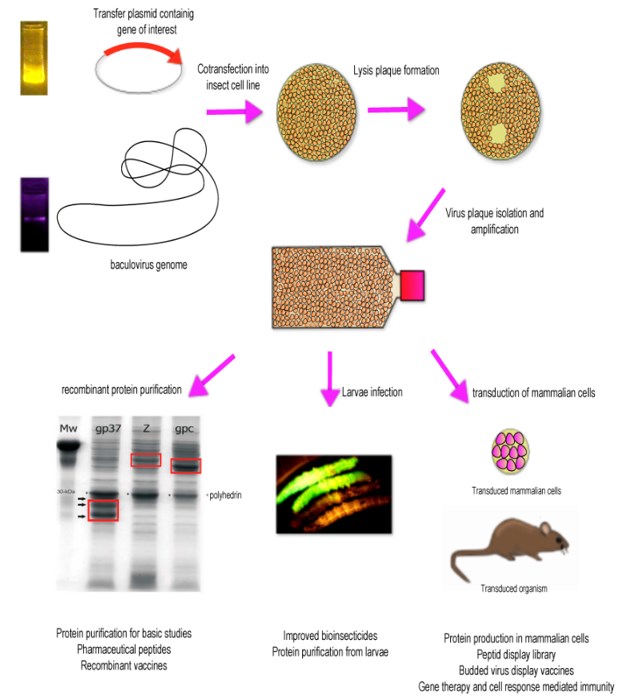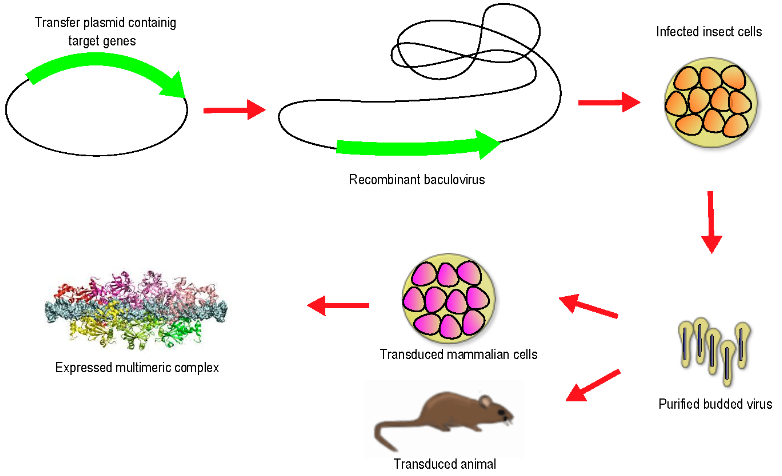Vectors Based on the Baculovirus
Biology of Baculovirus
Baculoviruses are arthropod-specific, enveloped viruses with circular, supercoiled double-stranded DNA genomes. They infect Lepidoptera (butterflies and moths), Hymenoptera (sawflies) and Diptera (mosquitoes). The baculovirus genome is replicated and transcribed in the nuclei of infected host cells, in which the large baculovirus DNA (between 80 and 200 kb) is packaged into rod-shaped nucleocapsids. Because the size of these nucleocapsids is flexible, baculovirus particles can accommodate large amounts of foreign DNA.
Autographa californica multiple nucleopolyhedroviruses (AcMNPV) is the most extensively studied baculovirus species, which infects only lepidopteran insects and cell lines. Infectious AcMNPV particles enter susceptible insect cells by facilitated endocytosis or fusion, and viral DNA is uncoated in the nucleus. Under in vivo and in vitro conditions, the baculovirus infection cycle can be divided into early and late stages. In the early stage, the infected insect cell releases extracellular virus particles (ECV) by budding from the cell membrane of infected cells. In the late phase of the infection cycle, occluded virus particles (OV) are assembled inside the nucleus. The OV is embedded in a homogenous matrix and released when the infected cells lyse during the last phase of the infection cycle. Occlusion bodies are visible under light microscopy where they appear as dark polygonal-shaped bodies filling up the nucleus of infected cells. Not all known baculoviruses form occlusion bodies. AcMNPV is representative of the group of occlusion body-positive baculoviruses.
Baculoviruses as Expression Vectors
The high levels of expression of the very late genes have been exploited to design the vectors for baculovirus-based foreign gene expression. Baculovirus expression vector (BEV) is a recombinant baculovirus that can infect insect cells or larvae where high levels of recombinant proteins are produced. Compared with prokaryotic expression systems, BEV provides appropriate post-translational modifications. The insect cells used in the baculovirus expression system are derived from lepidopteran insects and are relatively easy to grow. In addition, insect cells can be adapted to serum-free media, and recombinant protein production can be scaled up to pilot plant or larger bioreactors. Thereby, the proteins produced in the BEV can be used for functional studies, vaccine preparations or diagnostics.
In BEV, foreign gene coding sequences are usually placed under the transcriptional control of viral promoters. The most common method for producing recombinant baculovirus is shown in Figure 1. Baculovirus genomic DNA and transfer plasmids are co-transfected into insect cell culture. Double homologous recombination between the viral DNA and the transfer plasmid results in allelic replacement, which integrates the target gene into the baculovirus genome. Clonal purification requires several plaque passages. Thereafter, the virus stock can be produced and amplified to produce recombinant protein. Insect cells are used to purify proteins, including therapeutic and vaccine peptides. Larvae are used to reduce production costs or when recombinant baculovirus is tested as a biopesticide.
 Figure 1. The general process of producing recombinant baculovirus. (Haase, 2013)
Figure 1. The general process of producing recombinant baculovirus. (Haase, 2013)
Mammalian Cells Transduction and BacMam System
In 1995, it was discovered that AcMNPV can transfer the gene into mammalian cells and efficiently express the gene under the promoter that functions in the target cells. Therefore, baculoviruses can be used to transduce mammalian cells, produce therapeutic proteins or transduce organisms for gene therapy or vaccination. The term BacMam refers to baculovirus, in which, after virus transduction, a mammalian promoter is used to drive heterologous gene expression in mammalian cells after virus transduction (Figure 2). Since viral genomes can stably accommodate an insert sequence of at least 40 kb, BacMam is particularly suitable for expressing multimeric complexes. In recent years, BacMam has been used as a carrier to deliver many polypeptide genes (including secreted and transmembrane proteins) to mammalian cells. When using a high MOI, transduction efficiencies near 100% can be reached. With this high transduction efficiency and flexibility, BacMam can easily enable the coexpression of multiple genes with multiple baculoviruses and modulation of expression level by dosing and timing.
 Figure 2. Production of BacMam viruses. (Haase, 2013)
Figure 2. Production of BacMam viruses. (Haase, 2013)
Reference
- Haase, S.; et al. (2013). Genetic engineering of baculoviruses. Current Issues in Molecular Virology-Viral Genetics and Biotechnological Applications. Distributed under Open Access license CC BY 3.0, without modification.
